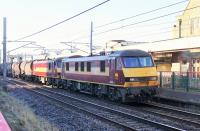Press Comment on Use of Electric Traction in Rail Freight [Rail Freight Group]
Date: 13/10/2021
Rail freight is acknowledged as a low carbon transport mode, emitting 76% less carbon dioxide than road freight even with use of diesel locomotives. Rail freight operators are committed to further decarbonisation, and measures to increase sustainability. However, the current significant increase in the wholesale cost of electricity for haulage means that some operators have had to take the regrettable decision to temporarily move back to diesel locomotives. A 200% increase in electricity costs for each train cannot be absorbed by the operators, or customers, and so necessary action is being taken to ensure that trains can continue to operate delivering vital goods across the country.
External links
Rail Freight Group
Rail freight is acknowledged as a low carbon transport mode, emitting 76% less carbon dioxide than road freight even with use of diesel locomotives. Rail freight operators are committed to further decarbonisation, and measures to increase sustainability. However, the current significant increase in the wholesale cost of electricity for haulage means that some operators have
Related images
Location: Arbroath ^The Dens^ Siding
Company: Arbroath and Forfar Railway
02/10/2008 Sandy Steele
Location: Carnforth
Company: Lancaster and Carlisle Railway
20/01/2016 Mark Bartlett
Related news items
Tags: x Electrifcation x Electricity Costs x Rail Freight x Rail Freight Group x COP26




